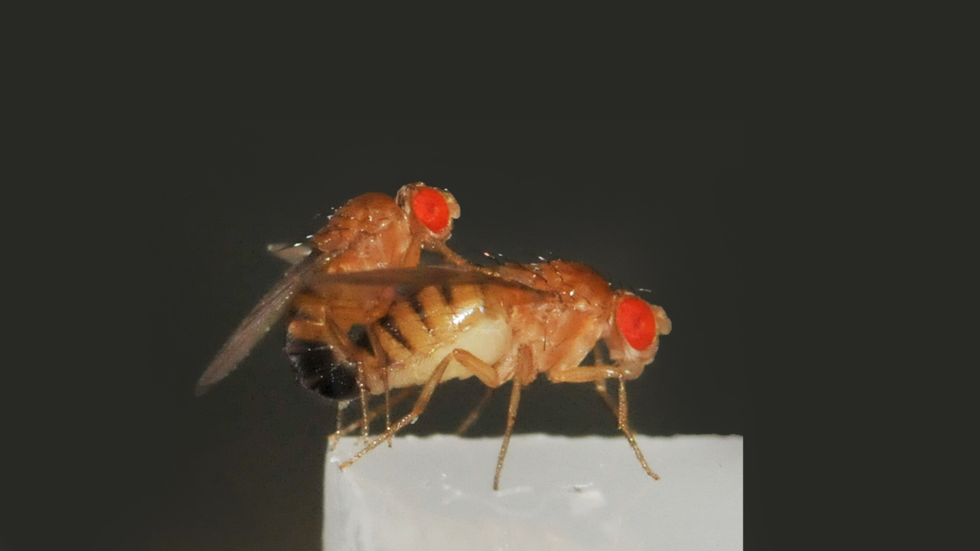
Biology
June 28, 2023
Boy fly meets girl fly meets AI: Training an AI to recognize fly mating identifies a gene for mating positions
A research group at the Graduate School of Science, Nagoya University in Japan has used artificial intelligence to determine that Piezo, a channel that receives mechanical stimuli, plays a role in controlling the mating posture of male fruit flies (Drosophila melanogaster). Inhibition of Piezo led the flies to adopt an ineffective mating posture that decreased their reproductive performance. Their findings were reported in iScience.
Most previous studies of animal mating have been limited to behavioral studies, limiting our understanding of this essential process. Since many animals adopt a fixed posture during copulation, maintaining an effective mating position is vital for reproductive success. In fruit flies, the male mounts the female and maintains this posture for at least until he transfers sufficient sperm to fertilize the female, which occurs about 8 minutes after copulation initiation. The Nagoya University research group realized that some factor was involved in maintaining this copulation posture.
A likely contender is Piezo. Piezo is a family of transmembrane proteins found in bristle cells, the sensitive cells in male genitals. Piezo is activated when a mechanical force is applied to a cell membrane, allowing ions to flow through the channel and generate an electrical signal. This signal triggers cellular responses, including the release of neurotransmitters in neurons and the contraction of muscle cells. Such feedback helps a fly maintain his mating position.
After identifying that the piezo gene is involved in the mating of fruit flies, Professor Azusa Kamikouchi (she/her), Assistant Professor Ryoya Tanaka (he/him), and student Hayato M. Yamanouchi (he/him) used optogenetics to further explore the neural mechanism of this phenomenon. This technique combines genetic engineering and optical science to create genetically modified neurons that can be inactivated with light of specific wavelengths. When the light was turned on during mating, the neuron was silenced. This allowed the researchers to manipulate the activity of piezo-expressing neurons.
“This step proved to be a big challenge for us,” Kamikouchi said. “Using optogenetics, specific neurons are silenced only when exposed to photostimulation. However, our interest was silencing neural activity during copulation. Therefore, we had to make sure that the light was only turned on during mating. However, if the experimenter manually turned the photostimulation on in response to the animal's copulation, they needed to observe the animal throughout the experiment. Waiting around for fruit flies to mate is incredibly time-consuming.”
The observation problem led the group to establish an experimental deep learning system that could recognize copulation. By training the AI to recognize when sexual intercourse was occurring, they could automatically control photostimulation. This allowed them to discover that when piezo-expressing neurons were inhibited, males adopted a wonky, largely ineffective mating posture. As one might expect, the males that showed difficulty in adopting an appropriate sexual position had fewer offspring. They concluded that a key role of the piezo gene was helping the male shift his axis in response to the female for maximum mating success.
“Piezo proteins have been implicated in a variety of physiological processes, including touch sensation, hearing, blood pressure regulation, and bladder function,” said Kamikouchi. “Now our findings suggest that reproduction can be added to the list. Since mating is an important behavior for reproduction that is widely conserved in animals, understanding its control mechanism will lead to a greater understanding of the reproductive system of animals in general.”
Kamikouchi is enthusiastic about the use of AI in such research. “With the recent development of informatics, experimental systems and analysis methods have advanced dramatically,” she concludes. “In this research, we have succeeded in creating a device that automatically detects mating using machine learning-based real-time analysis and controls photostimulation necessary for optogenetics. To investigate the neural mechanisms that control animal behavior, it is important to conduct experiments in which neural activity is manipulated only when an individual exhibits a specific behavior. The method established in this study can be applied not only to the study of mating in fruit flies but also to various behaviors in other animals. It should make a significant contribution to the promotion of neurobiological research.”
The study, "Piezo-mediated mechanosensation contributes to stabilizing copulation posture and reproductive success in Drosophila males," has been published in the journal iScience at https://doi.org/10.1016/j.isci.2023.106617.
Authors:
Hayato M Yamanouchi, Ryoya Tanaka, and Azusa Kamikouchi
Media Contact:
Matthew Coslett
International Communications Office, Nagoya University
kouho-en@adm.nagoya-u.ac.jp